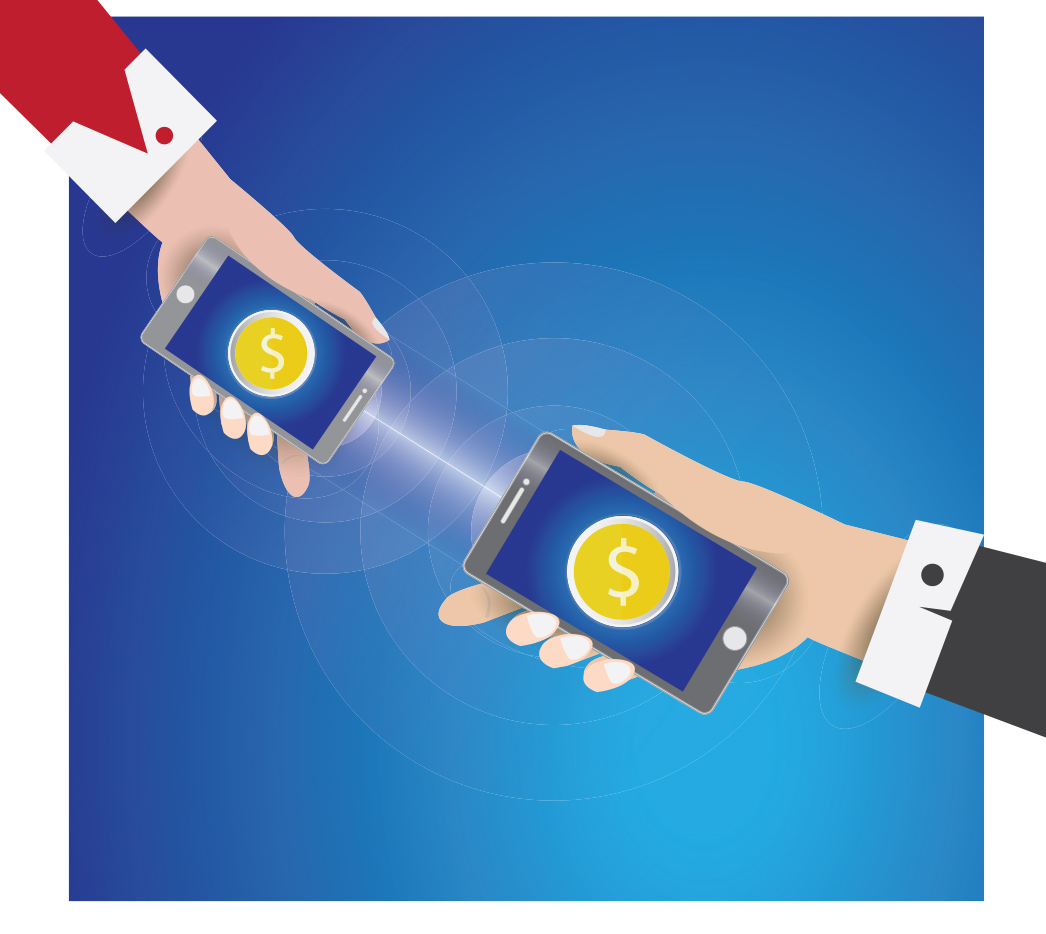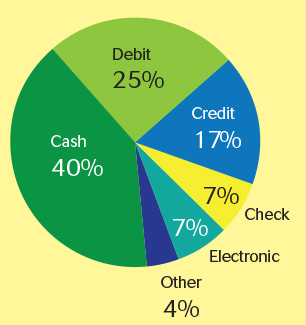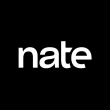P2P: Poised for Growth?
 With tech giants investing in P2P payments—and millennials driving usage—a niche may finally be ready for the mainstream.
With tech giants investing in P2P payments—and millennials driving usage—a niche may finally be ready for the mainstream.
Few areas of financial services have seemed as ripe for disruption as peer-to-peer (P2P) payments, where old-school methods of cash and checks still dominate. A plethora of electronic P2P payment technologies enabling users to pay one another quickly and securely online or via apps have been developed and improved upon in recent years but have failed to catch on in a big way. One of the biggest obstacles, experts say, is the difficulty of changing consumers’ entrenched behaviors and the relative convenience of existing systems (see “Cash’s Tenacious Grip”).
| Cash’s Tenacious Grip
P2P payments technology faces many challenges before consumers broadly accept it, and the biggest one is ubiquitous: Cash. Despite the sharp rise of cards and electronic payments in recent decades, cash is still king in routine payments among consumers, and check-writing is down but not out. About three-quarters of all checks written are for $500 or less, according to the Federal Reserve, and though check writing has declined dramatically over the last decade, Fed data show the smallest decrease was among checks written from one consumer to another. Whether it’s for splitting the tab, sharing housing expenses or paying for the babysitter, Fed data suggest the vast majority of consumers still are wedded to using cash or checks. U.S. Share of Payment Type by Number of Transactions SOURCE: Federal Reserve Payments Study, 2013 |
Other major barriers include the fragmented marketplace. Senders usually must enlist each new recipient to establish an account or download an app to claim the funds, which slows take-up. The speed of P2P funds transfers also can vary widely, from near real time for some in-app transfers to several days, especially when they involve different financial institutions. Consumer concern about payments security at a time when data breaches seem commonplace also could be discouraging prospective P2P users from sharing their account details on apps and with new payees.
These challenges haven’t stopped providers looking to stake theirclaim in P2P payments. Facebook introduced a P2P service in 2015; more banks are touting their P2P offerings; Apple and Microsoft are making noise about entering P2P and—perhaps most significantly—PayPal Inc.’s Venmo subsidiary is gaining steam with millennials (see sidebar below). “For ageneration that has never written a check, Venmo is the way to pay the rent, pay back a friend and it is in the middle of how the millennial generation manages and moves its money,” PayPal CEO Dan Schulman told analysts in July 2015.
Millennial Momentum
Millennials could be the force that helps P2P break into real growth because of patterns emerging with their use of mobile payments, according to Marianne Berry, a managing director at Auriemma Consulting. “Millennials are leading growth of mobile payments, according to our consumer research, and it makes sense that they’ll look to their phones as the way to pay their peers,” she tells Paybefore. Millennials already are promoting P2P through social media and word of mouth, Berry adds. “Millennials don’t mind telling each other to just download the app when they want to pay each other, and through those pockets of influence, P2P is growing gradually,” she believes.
Size estimates of the emerging U.S. P2P payments market vary based on how transactions are defined. First Annapolis in 2012 predicted the niche would grow to $50 billion by 2017. In 2014, 451 Research forecast that P2P transaction volume would grow more than 300 percent over four years, from 172.9 million transactions in 2014 to 722.3 million in 2018. Similar development is occurring with P2P outside the U.S.; in the U.K., P2P payments also are seeing significant growth with the launch of Paym, a mobile P2P service backed by the U.K.’s Payments Council; Barclays’ Pingit and NatWest’s Pay Your Contacts are two other U.K. P2P services that show promise. Faster Payments, which launched in 2008, has the lead in enabling P2P payments for banked U.K. consumers.
So far, most domestic P2P payment services (excluding wire transfers) are either very low-cost or free, but analysts say immediate profitability may not be the end game in P2P technology. “The payments industry is going through major changes, and though P2P right now is a relatively narrow area, it may eventually become a key way individuals routinely move funds to one another,” Berry notes. “Payments providers investing in P2P now may be laying the groundwork for ‘sticky’ services that are part of larger products and services in years to come,” she speculates. Though it’s still early in the evolution of P2P payment services, it seems a fair bet that a critical mass of consumers eventually will grow comfortable with using digital P2P services. If and when that happens, the P2P brands with scale will be at least poised to win deeper consumer engagement if not new revenue streams, analysts suggest.
P2P’s Biggest Potential Players
Apple Inc.: P2P on the Road Map? In July of 2015, it came to light that the tech titan filed for a patent in 2014 suggesting it has plans to extend P2P services to Apple Pay users. The patent describes a service enabling Apple Pay users to send payments linked to a bank account or payment card to one another via Apple’s encrypted, secure element-based payments technology and Touch ID. Apple in November was reported to be in talks with U.S. banks about adding a P2P service and rumors continue to swirl around Apple’s P2P plans.
clearXchange (recently merged with Early Warning): Bank to Bank. Formed in 2011 and equally owned by Bank of America, JPMorgan Chase & Co., Wells Fargo & Co. and Capital One, clearXchange is a digital payments network enabling bank members’ customers to send payments to anyone with a U.S. bank account using an email address or a mobile number. Customers of non-participating banks may receive P2P payments by creating a clearXchange profile. Combined, member banks reach more than 250 million customers and more than 6,000 banks used clearXchange during the second quarter of 2015. Banks often white-label the service (Chase offers it as QuickPay).
FIS: People Pay. FIS in 2013 introduced People Pay, a white-label P2P service for financial institutions enabling bank customers to send funds to peers, whether or not their bank supports People Pay. Senders must provide the recipient’s mobile phone number, email address or bank account number; transfers between customers of banks with People Pay take place in real time.
Facebook: P2P via Messenger. Facebook in June 2015 rolled out a P2P payments service in the U.S., through its Facebook Messenger app. Users may send funds by starting a message and tapping the $ icon and entering the amount. Funds are sent immediately to the recipient’s enrolled debit card; the cost is free (there is no credit card option). Messenger has more than 700 million monthly active users worldwide.
Fiserv: Popmoney Between Banks. Fiserv offers Popmoney, a P2P service that got its start in 2009. Popmoney enables users to send money to others directly from their existing bank accounts, with senders notified via a text or email. Sending money from Popmoney. com or the Popmoney app costs 95 cents. Fees for sending money from financial institutions vary, with most offering standard payments for free. Receiving money is free. Popmoney is available through more than 2,400 financial institutions, reaching 70 million consumers. Real-time payments are available at more than 160 participating FIs.
Google Inc.: P2P Free in Gmail, Google Wallet. Google Inc. in 2013 introduced P2P services via its Gmail email service, and simultaneously integrated the feature with Google Wallet. Gmail users may send funds to anyone with an email account; recipients must sign up for Google Wallet to receive funds. There is no fee, and transfers can be funded only from a Google Wallet balance, debit card or linked bank account (which can take up to several days). Google in 2015 expanded P2P services via Gmail to users within the U.K.
MasterCard: Riding Debit Rails. In May 2015 MasterCard introduced MasterCard Send, a new platform enabling MasterCard customers to send funds that can be received within seconds by any debit card or bank account. MasterCard Send enables funds to be sent quickly and securely to consumers domestically and internationally from other consumers or from governments, businesses and nonprofits. In the U.S. MasterCard Send is provided to consumers via P2P providers (issuers, money transfer operators, merchants, others), remittance providers, businesses, governments and other “senders” that send funds to consumers. It enables crossborder payments originating in the U.S. and in more than 200 countries.
Microsoft: Laying P2P Groundwork? Microsoft captured P2P watchers’ attention with news that the tech giant has applied for money transmitter licenses in all 48 U.S. states that require them and has registered with FinCEN as a money services business. Microsoft’s new Windows 10 also has features that could support a biometrics-based approach to authenticating users for payments.
PayPal: P2P Pioneer. Founded in 1998 with P2P as a core service, PayPal claims 169 million active mobile wallets in 26 currencies across 190 nations. It’s free to send funds in the U.S. using a bank account or PayPal balance; via debit or credit card is 2.9 percent plus $0.30/transaction within U.S. Outside the U.S., it costs between 0.5 to 2 percent using a bank account or PayPal balance; 3.4 to 3.9 percent using debit or credit card.
Square Cash: Free for Debit Card Users. Square Inc. in 2013 expanded beyond its core m-POS services to begin supporting free P2P payments for Visa and MasterCard debit card customers via email and within the Square Cash app. Funds transfers can take one to two days to settle. Square says it processes $1 billion annually in P2P transfers. Square enables businesses to accept consumer payments via Square Cash, charging a 1.5 percent processing fee for each transaction.
Venmo: Popular with Millennials. Founded in 2009, Venmo in 2012 was acquired by Braintree for $26.2 million (PayPal then absorbed Braintree in 2013). The company has about 60 employees and provides P2P service via an app. Venmo is free when sending funds within the U.S. from bank accounts or debit cards; the fee for sending funds from a credit card is 3 percent. The startup handled $2.4 billion in P2P transfers in 2014 and processed $1.6 billion in transaction volume during the quarter ended June 30, 2015, a 247 percent increase over the same period a year earlier.
Visa: Connecting Consumers. Visa Direct enables consumers to transfer funds from one Visa account to another by taking advantage of Visa Inc.’s existing network of more than 14,500 financial institutions in more than 200 countries and territories, tens of millions of merchants and 2.1 billion Visa accounts in markets around the world. Visa Direct is offered to consumers in 25 countries in partnership with more than 100 financial institutions. Consumers can initiate a Visa Direct transaction through many channels, including bank branch, ATM, online, kiosk or mobile phone.












































